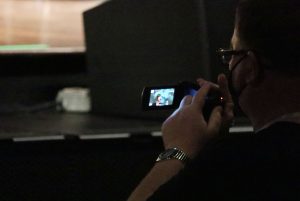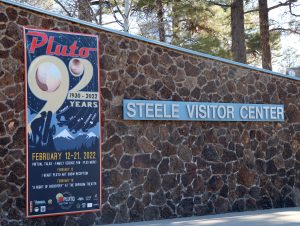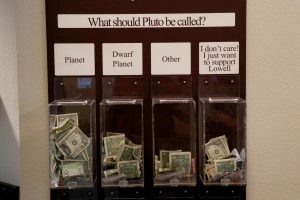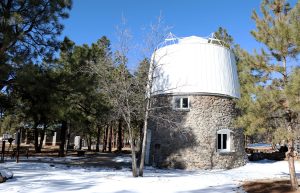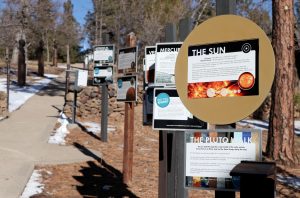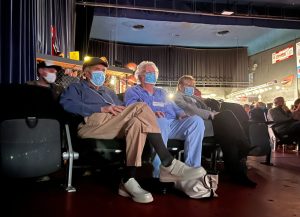- Slug: BC-CNS Pluto at 92, 710 words
- 1 audio story here, credit Emma VandenEinde/Cronkite News.
- 10 photos and captions below.
By Hope O’Brien
Cronkite News
FLAGSTAFF – Clyde Tombaugh sat in the Orpheum Theater that fateful night in February 1930, waiting for clouds to pass before the 24-year-old astronomer could return to Lowell Observatory to confirm his discovery of a ninth planet in our solar system.
In that same theater 92 years later, during the I Heart Pluto Festival celebrating the discovery, Alden Tombaugh reflected on his father’s legacy of inspiration.
When he speaks about his father, it isn’t the discovery of Pluto that he remembers most, it’s his dad’s love of sharing astronomy with others, particularly children.
“It makes me enthusiastic about the future to think that people are still interested in that process and becoming involved in planetary science or any type of astronomy and the scientific method in and of itself,” said Tombaugh, a former banker and contractor.
That same finding that brought astronomical fame to Flagstaff and the Tombaugh family has provided Lowell Observatory with a tradition they hope to continue for generations to come by celebrating one of the city’s defining scientific moments.
Kevin Schindler, who has been the historian at Lowell Observatory since 2015, hopes young children who see what happened there will be inspired by the work of Clyde Tombaugh, who died in 1997.
Inspiring a new generation
Children like Cameron Dick, 11, who’s interested in black holes and theoretical physics. He lives in a city where science is in the backyard and events like the I Heart Pluto Festival provide an outlet for new generations of Arizonans interested in science.
Aaron Dick, Cameron’s father, said he hopes his children take away an appreciation of “science and learning about research and how to do research.”
At Lowell, just a mile up the road from the theater, visitors follow a path of descriptive signs and busts, named the Pluto Walk, leading to the room where Clyde Tombaugh spent hours peering into the heavens.
Schindler said the discovery of Pluto – even though Pluto now is designated a dwarf planet – has shaped Flagstaff and northern Arizona.
“Flagstaff and even Arizona, you could say, is the home of Pluto, and I think there’s a lot of pride that goes with that,” he said. “If you’re from Flagstaff, you’re from the home of Pluto, and you know, it’s important both scientifically but also culturally, because the community does embrace that heritage.”
When Schindler speaks of Tombaugh’s discovery, it’s with admiration and awe that it still moves young people nearly a century later.
“He was 24 years old when he discovered this planet,” Schindler said, “and so when he was younger, he spent a lot of nights by himself on the farm, building his own telescopes. He just found it interesting, so I think it’s inspiring to think that anybody could achieve this.”
He gave her the moon
James Christy, who was an astronomer at the U.S. Naval Observatory in Flagstaff, was among the I Heart Pluto celebrants at the Orpheum on Feb. 18.
In 1978, nearly a half century after Tombaugh’s discovery, Christy noticed a discrepancy on some of the slides picturing Pluto – a discrepancy that later would prove to be Pluto’s largest moon.
The astronomer emphasized the most important piece of his tale: how he chose the moon’s name.
Christy wanted to combine Char, the diminutive for Charlene, his wife’s name, with “on,” an ending used for newly discovered particles. But because planets and their moons traditionally are named after figures in Greek and Roman mythology, Christy told his wife Charon wouldn’t work. But a quick look in a dictionary saved the day: Charon was the ferryman of souls across the River Styx in Greek mythology.
Where Pluto stands today
In 2006, astronomers at the meeting of the International Astronomical Union voted to demote Pluto to dwarf status, arguing it didn’t meet the union’s criteria for being a full-size planet because it has not become gravitationally dominant – known in astronomy circles as “clearing the neighborhood” around its orbit.
That decision has been widely debated, particularly at Lowell Observatory.
The decision, Schindler said, was made on the final day of the union’s meeting, when fewer members were present.
“That’s just not how science is done,” he said. “Science is done by acclamation, not by voting, but based on the evidence.”
For more stories from Cronkite News, visit cronkitenews.azpbs.org.
^__=
